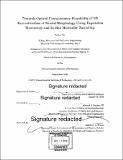Towards optical connectomics : feasibility of 3D reconstruction of neural morphology using expansion microscopy and in situ molecular barcoding
Author(s)
Dai, Peilun
DownloadFull printable version (3.419Mb)
Alternative title
Feasibility of 3D reconstruction of neural morphology using expansion microscopy and in situ molecular barcoding
Other Contributors
Massachusetts Institute of Technology. Department of Brain and Cognitive Sciences.
Advisor
Edward S. Boyden, III.
Terms of use
Metadata
Show full item recordAbstract
Reconstruction of the 3D morphology of neurons is an essential step towards the analysis and understanding of the structures and functions of neural circuits. Optical microscopy has been a key technology for mapping brain circuits throughout the history of neuroscience due to its low cost, wide usage in biological sciences and ability to read out information-rich molecular signals. However, conventional optical microscopes have limited spatial resolution due to the diffraction limit of light, requiring a tradeoff between the density of neurons to be imaged and the ability to resolve finer structures. A new technology called expansion microscopy (ExM), which physically expands the specimen multiple times before optical imaging, enables us to image fine structures of biological tissues with super resolution using conventional optical microscopes. With the help of ExM, we can also read out molecular information in the neural tissues optically. In this thesis, I will introduce our study of the properties, via computer simulation, of a candidate automated approach to algorithmic reconstruction of dense neural morphology, based on simulated data of the kind that would be obtained via two emerging molecular technologies-expansion microscopy (ExM) and in-situ molecular barcoding. We utilize a convolutional neural network to detect neuronal boundaries from protein-tagged plasma membrane images obtained via ExM, as well as a subsequent supervoxel-merging pipeline guided by optical readout of information-rich, cell-specific nucleic acid barcodes. We attempt to use conservative imaging and labeling parameters, with the goal of establishing a baseline case that points to the potential feasibility of optical circuit reconstruction, leaving open the possibility of higher-performance labeling technologies and algorithms. We find that, even with these conservative assumptions, an all-optical approach to dense neural morphology reconstruction may be possible via the proposed algorithmic framework.
Description
Thesis: S.M. in Neuroscience, Massachusetts Institute of Technology, Department of Brain and Cognitive Sciences, 2018. Cataloged from PDF version of thesis. Includes bibliographical references (pages 27-29).
Date issued
2018Department
Massachusetts Institute of Technology. Department of Brain and Cognitive SciencesPublisher
Massachusetts Institute of Technology
Keywords
Brain and Cognitive Sciences.